Samuel de Champlain
Samuel de Champlain was a French explorer and cartographer best known for establishing and governing the settlements of New France and the city of Quebec.
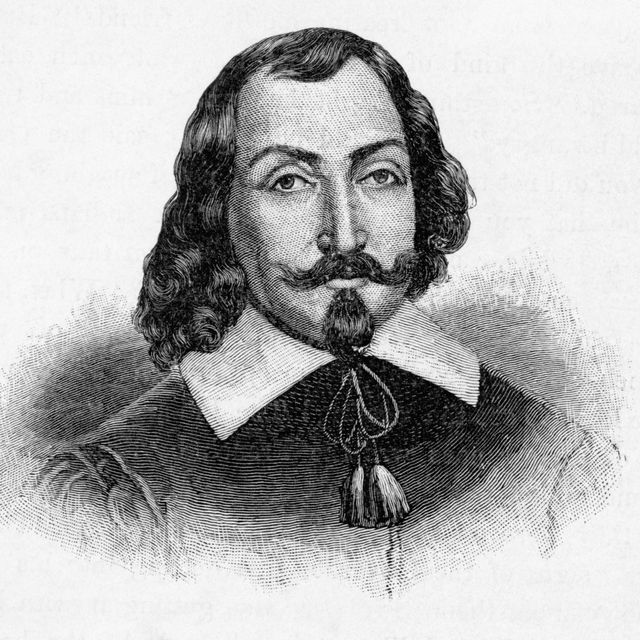

Who Was Samuel de Champlain?
French explorer Samuel de Champlain began exploring North America in 1603, establishing the city of Quebec in the northern colony of New France, and mapping the Atlantic coast and the Great Lakes, before settling into an administrative role as the de facto governor of New France in 1620.
Samuel de Champlain was born in 1574 (according to his baptismal certificate, which was discovered in 2012), in Brouage, a small port town in the province of Saintonge, on the western coast of France. Although Champlain wrote extensively of his voyages and later life, little is known of his childhood. He was likely born a Protestant, but converted to Catholicism as a young adult.
First Explorations and Voyages
Champlain's earliest travels were with his uncle, and he ventured as far as Spain and the West Indies. From 1601 to 1603, he was a geographer for King Henry IV, and then joined François Gravé Du Pont's expedition to Canada in 1603. The group sailed up the St. Lawrence and Saguenay rivers and explored the Gaspé Peninsula, ultimately arriving in Montreal. Although Champlain had no official role or title on the expedition, he proved his mettle by making uncanny predictions about the network of lakes and other geographic features of the region.
Given his usefulness on Du Pont's voyage, the following year Champlain was chosen to be geographer on an expedition to Acadia led by Lieutenant-General Pierre Du Gua de Monts. They landed in May on the southeast coast of what is now Nova Scotia and Champlain was asked to choose a location for a temporary settlement. He explored the Bay of Fundy and St. John River area before selecting a small island in the St. Croix River. The team built a fort and spent the winter there.
In the summer of 1605, the team sailed down the coast of New England as far south as Cape Cod. Although a few British explorers had navigated the terrain before, Champlain was the first to give a precise and detailed accounting of the region that would one day become Plymouth Rock.
Establishing Quebec
In 1608, Champlain was named lieutenant to de Monts, and they set off on another expedition up the St. Lawrence. When they arrived in June 1608, they constructed a fort in what is now Quebec City. Quebec would soon become the hub for French fur trading. The following summer, Champlain fought the first major battle against the Iroquois, cementing a hostile relationship that would last for more than a century.
In 1615, Champlain made a brave voyage into the interior of Canada accompanied by a tribe of Native Americans with whom he had good relations, the Hurons. Champlain and the French aided the Hurons in an attack on the Iroquois, but they lost the battle and Champlain was hit in the knee with an arrow and unable to walk. He lived with the Hurons that winter, between the foot of Georgian Bay and Lake Simcoe. During his stay, he composed one of the earliest and most detailed accounts of Native American life.
Later Years and Death
When Champlain returned to France, he found himself embroiled in lawsuits and was unable to return to Quebec. He spent this time writing the stories of his voyages, complete with maps and illustrations. When he was reinstated as lieutenant, he returned to Canada with his wife, who was 30 years his junior. In 1627, Louis XIII's chief minister, Cardinal de Richelieu, formed the Company of 100 Associates to rule New France and placed Champlain in charge.
Things didn't go smoothly for Champlain for long. Eager to capitalize on the profitable fur trade in the region, Charles I of England commissioned an expedition under David Kirke to displace the French. They attacked the fort and seized supply ships, cutting off necessities to the colony. Champlain surrendered on July 19, 1629 and returned to France.
Champlain spent some time writing about his travels until, in 1632, the British and the French signed the Treaty of Saint-Germain-en-Laye, returning Quebec to the French. Champlain returned to be its governor. By this time, however, his health was failing and he was forced to retire in 1633. He died in Quebec on Christmas Day in 1635.
Related Videos
Quick facts.
- Name: Samuel de Champlain
- Birth City: Brouage, Province of Saintonge
- Birth Country: France
- Gender: Male
- Best Known For: Samuel de Champlain was a French explorer and cartographer best known for establishing and governing the settlements of New France and the city of Quebec.
- Politics and Government
- War and Militaries
- Technology and Engineering
- Nacionalities
- Death Year: 1635
- Death date: December 25, 1635
- Death City: Quebec
- Death Country: Canada
We strive for accuracy and fairness. If you see something that doesn't look right, contact us !
- The advice I give to all adventurers is to seek a place where they may sleep in safety.

European Explorers

Was Christopher Columbus a Hero or Villain?

Christopher Columbus

10 Famous Explorers Who Connected the World

Sir Walter Raleigh

Ferdinand Magellan

Juan Rodríguez Cabrillo

Leif Eriksson

Vasco da Gama

Bartolomeu Dias

Giovanni da Verrazzano

Jacques Marquette

René-Robert Cavelier, Sieur de La Salle
Virtual museum of New France

- Virtual museum of new France
- Introduction
- Colonies and Empires
The Explorers
- Economic Activities
- Useful links

- North America Before New France
- From the Middle Ages to the Age of Discovery
- Founding Sites
- French Colonial Expansion and Franco-Amerindian Alliances
- Other New Frances
- Other Colonial Powers
- Wars and Imperial Rivalries
- Governance and Sites of Power
- Jacques Cartier 1534-1542
Samuel de Champlain 1604-1616
- Étienne Brûlé 1615-1621
- Jean Nicollet 1634
- Jean de Quen 1647
- Médard Chouart Des Groseilliers 1654-1660
- Pierre-Esprit Radisson 1659-1660
- Nicolas Perrot 1665-1689
- René-Robert Cavelier de La Salle 1670-1687
- Charles Albanel 1672
- Jacques Marquette 1673
- Louis Jolliet 1673-1694
- Louis Hennepin 1678-1680
- Daniel Greysolon Dulhut 1678-1679
- Louis-Armand de Lom d’Arce, baron Lahontan 1684-1689
- Pierre de Troyes 1686
- Pierre Le Moyne d’Iberville 1686-1702
- Antoine Laumet dit de Lamothe Cadillac 1694-1701
- Pierre Gaultier de Varennes et de La Vérendrye 1732-1739
- Basque Whalers
- Industrial Development
- Commercial Networks
- Immigration
- Social Groups
- Religious Congregations
- Pays d’en Haut and Louisiana
- Entertainment
- Communications
- Health and Medicine
- Vernacular Architecture in New France
Samuel de Champlain (sometimes called Samuel Champlain in English documents) was born at Brouage, in the Saintonge province of Western France, about 1570. He wrote in 1613 that he acquired an interest “from a very young age in the art of navigation, along with a love of the high seas.” He was not yet twenty when he made his first voyage, to Spain and from there to the West Indies and South America. He visited Porto Rico (now Puerto Rico,) Mexico, Colombia, the Bermudas and Panama. Between 1603 and 1635, he made 12 stays in North America. He was an indefatigable explorer – and an assistant to other explorers – in the quest for an overland route across America to the Pacific, and onwards to the riches of the Orient.
The Mystery of Samuel de Champlain
In the title of his first book, published in 1603, Des Sauvages, ou voyage de Samuel Champlain, de Brouage, fait en la France nouvelle l’an mil six cens trois… [“Concerning the Primitives: Or Travels of Samuel Champlain of Brouage, Made in New France in the Year 1603”], Samuel de Champlain indicated that he was a native of Brouage in the Saintonge region of France. But a fire in the 17th century completely destroyed the town records of Brouage, where the young Champlain was believed to have spent his childhood. Since then, historians have speculated about the birth date of the man often described as the “Father of New France.”
The name “Samuel,” taken from the Old Testament, suggests the possibility that Champlain was born into a Protestant family during a period when France was torn by endless conflicts over religion. However, by the time he undertook his voyages of discovery and exploration to Canada, he had definitely converted to Catholicism. The marriage contract between Samuel de Champlain and Hélène Boullé, dated 1610, shows that he was the son of the then-deceased sea captain, Anthoine de Champlain, and Marguerite Le Roy. On this basis, several historians have deduced that Champlain must have been born around 1570.
These are the few facts that history reveals, leaving room for all sorts of hypotheses about Champlain’s date of birth. But things were to take a different turn in the spring of 2012 when Jean-Marie Germe, a French genealogist, was examining the archives of the Protestant parish of Saint Yon de La Rochelle. In Champlain’s time, La Rochelle was a neighbouring town and rival of Brouage. What Mr. Germe found there was the baptismal record of Samuel Chapeleau, son of Antoine Chapeleau and Marguerite Le Roy, dated August 13, 1574.
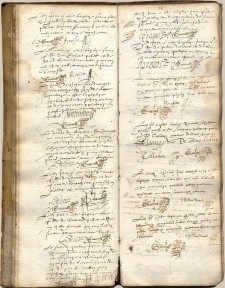
Baptismal certificate of our Samuel de Champlain
Is this the baptismal certificate of the “Father of New France”? Certainly the document is difficult to read; the letters often have to be deciphered as much from their context, as from their appearance. Moreover, in that era the rules of spelling were flexible, to say the least. The different spellings used for the family name of the child and his father can be explained by the fact these names had perhaps previously been written down only rarely. A standard spelling had possibly not yet been adopted.
What are the chances of finding another baptismal certificate dating from this era where the names are identical to those we find in other historical documents? The chances are in fact very small indeed. However, even though the family names of Chapeleau and Champlain are similar, this small difference — understandable as it may be — cautions us not to jump to conclusions. Although the probability is slight, it is still possible that this document has nothing to do with our Samuel de Champlain.
If we are indeed looking at the baptismal certificate of our Samuel de Champlain, we can now say for certain that he was born into a Protestant family, most probably during the summer of 1574. But unless there is another discovery to equal the one made by Mr. Germe, a complete mystery will continue to surround Samuel de Champlain’s date and place of birth.
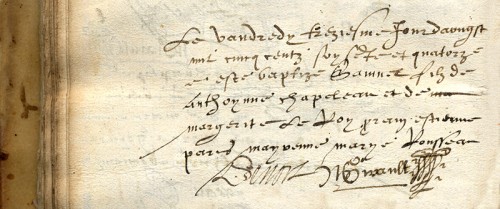
Baptismal certificate of our Samuel de Champlain, detail
“On Friday, the thirteenth day of August, fifteen hundred and seventy-four, Samuel, son of Antoine Chapeleau and of m [word crossed out] Marguerite Le Roy, was baptized. Godfather, Étienne Paris; godmother, Marie Rousseau. Denors N. Girault.”
In the Footsteps of Jacques Cartier
In 1602 or thereabouts, Henry IV of France appointed Champlain as hydrographer royal. Aymar de Chaste, governor of Dieppe in Northern France, had obtained a monopoly of the fur trade and set up a trading post at Tadoussac. He invited Champlain to join an expedition he was sending there. Champlain’s mission was clear; it was to explore the country called New France, examine its waterways and then choose a site for a large trading factory.
Thus Champlain sailed from Honfleur on the fifteenth of March, 1603, and prepared to follow the route that Jacques Cartier had opened up in 1535. He proceeded to explore part of the valley of the Saguenay river and was led to suspect the existence of Hudson Bay. He then sailed up the St. Lawrence as far as Hochelaga (the site of Montreal.) Nothing was to be seen of the Amerindian people and village which Cartier had visited, and Sault St. Louis (the Lachine Rapids) still seemed impassable. However, Champlain learned from his guides that above the rapids there were three great lakes (Erie, Huron and Ontario) to be explored.
Acadia and the Atlantic Coast
After Aymar de Chaste died in France in 1603, Pierre Du Gua de Monts became lieutenant-general of Acadia. In exchange for a ten years exclusive trading patent, de Monts undertook to settle sixty homesteaders a year in that part of New France. From 1604 to 1607, the search went on for a suitable permanent site for them. It led to the establishment of a short-lived settlement at Port Royal (Annapolis Royal, Nova Scotia.)
While the settlers were tilling, building, hunting and fishing, Champlain carried on with his appointed task of investigating the coastline and looking for safe harbours.
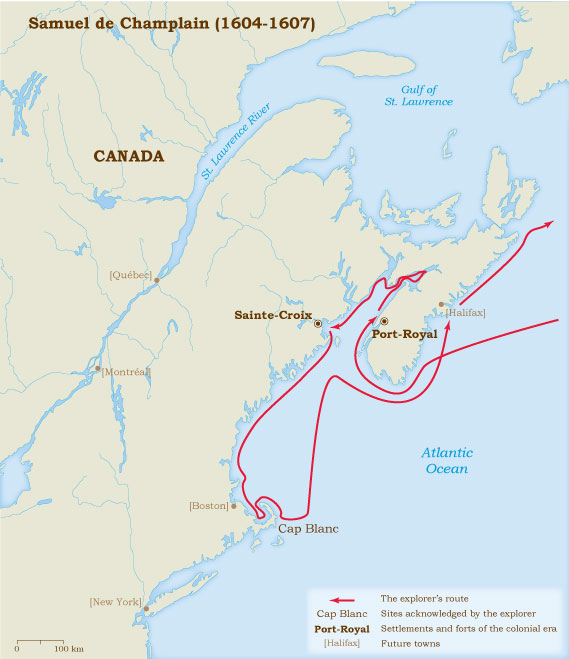
The three years stay in Acadia allowed him plenty of time for exploration, description and map-making. He journeyed almost 1,500 kilometres along the Atlantic coast from Maine as far as southernmost Cape Cod.
From Quebec to Lake Champlain
In 1608, Champlain proposed a return to the valley of the St. Lawrence, specifically to Stadacona, which he called Quebec. In his opinion, nowhere else was so suitable for the fur trade and as a starting point from which to search for the elusive route to China. During this third voyage he learned of the existence of Lac Saint Jean (Lake St. John), and on the third of July, 1608, he founded what was to become Quebec City. He immediately set about building his Habitation (residence) there.
Champlain also explored the Iroquois River (now called the Richelieu), which led him on the fourteenth of July, 1609, to the lake which would later bear his name. Like the traders who had preceded him, he sided with the Hurons, Algonquins and Montaignais against the Iroquois. This intervention in local politics was ultimately responsible for the warlike relations that were to pit the Iroquois against the French for generations.
From the Ottawa Valley to Lake Huron
In 1611, Champlain returned to the area of the Hochelaga islands. He found an ideal harbour, and facing it he built the Place Royale (royal square), around which the town would later develop from 1642 onwards.
Even more important, he succeeded in penetrating beyond the Lachine Rapids, becoming the first European (apart from Étienne Brûlé) to start exploring the St. Lawrence and its tributaries as a route towards the interior of the continent. Champlain was so convinced that it was the route to the Orient that in 1612 he obtained a commission to “search for a free passage by which to reach the country called China.” Like most of the explorers who followed after him, he could not carry out his mission without the support of the Amerindian population.
The following year Champlain was induced to make a voyage up the Ottawa River in the course of which he reached Allumette Island. It was his initial foray along the route that was to lead him to the heartland of present-day Ontario and eventually to reach Lake Huron on the first of August, 1615.
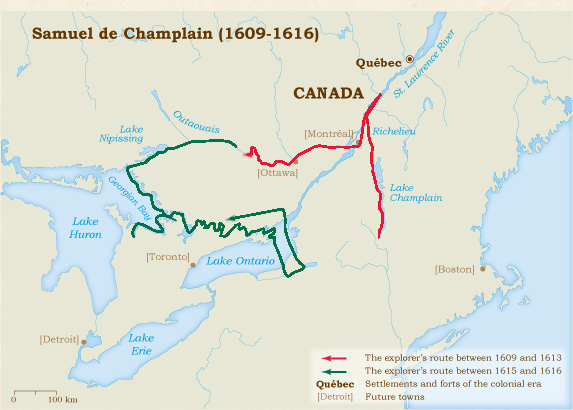
That was to be Champlain’s last voyage of exploration. In the years that followed, he devoted all his efforts to founding a French colony in the St. Lawrence valley. The keystone of his project was the settlement at Quebec.
When it capitulated to the English Kirke brothers in 1629, Champlain returned to France, where he lobbied incessantly for the cause of New France. He finally returned to Canada on the twenty-second of May, 1633. At the time of his death at Quebec on the twenty-fifth of December, 1635, there were one hundred and fifty French men and women living in the colony.

The Ages of Exploration
Samuel de champlain interactive map, age of discovery.
Quick Facts:
Samuel de Champlain took several voyages to Canada, where he mapped the St. Lawrence River and became the first European to discover the Great Lakes
Click on the world map to view an example of the explorer’s voyage.
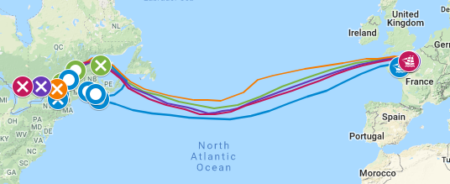
How to Use the Map
- Click on either the map icons or on the location name in the expanded column to view more information about that place or event
- The Mariners' Educational Programs
- Bibliography
Ask the publishers to restore access to 500,000+ books.
Internet Archive Audio

- Grateful Dead
- Old Time Radio
- 78 RPMs and Cylinder Recordings
- Audio Books & Poetry
- Computers, Technology and Science
- Music, Arts & Culture
- News & Public Affairs
- Spirituality & Religion
- Radio News Archive

- Flickr Commons
- Occupy Wall Street Flickr
- NASA Images
- Solar System Collection
- Ames Research Center

- All Software
- Old School Emulation
- MS-DOS Games
- Historical Software
- Classic PC Games
- Software Library
- Kodi Archive and Support File
- Vintage Software
- CD-ROM Software
- CD-ROM Software Library
- Software Sites
- Tucows Software Library
- Shareware CD-ROMs
- Software Capsules Compilation
- CD-ROM Images
- ZX Spectrum
- DOOM Level CD

- Smithsonian Libraries
- FEDLINK (US)
- Lincoln Collection
- American Libraries
- Canadian Libraries
- Universal Library
- Project Gutenberg
- Children's Library
- Biodiversity Heritage Library
- Books by Language
- Additional Collections

- Prelinger Archives
- Democracy Now!
- Occupy Wall Street
- TV NSA Clip Library
- Animation & Cartoons
- Arts & Music
- Computers & Technology
- Cultural & Academic Films
- Ephemeral Films
- Sports Videos
- Videogame Videos
- Youth Media
Search the history of over 866 billion web pages on the Internet.
Mobile Apps
- Wayback Machine (iOS)
- Wayback Machine (Android)
Browser Extensions
Archive-it subscription.
- Explore the Collections
- Build Collections
Save Page Now
Capture a web page as it appears now for use as a trusted citation in the future.
Please enter a valid web address
- Donate Donate icon An illustration of a heart shape
Voyages of Samuel de Champlain, 1604-1618;
Bookreader item preview, share or embed this item, flag this item for.
- Graphic Violence
- Explicit Sexual Content
- Hate Speech
- Misinformation/Disinformation
- Marketing/Phishing/Advertising
- Misleading/Inaccurate/Missing Metadata
![[WorldCat (this item)] [WorldCat (this item)]](https://archive.org/images/worldcat-small.png)
plus-circle Add Review comment Reviews
3 Favorites
DOWNLOAD OPTIONS
For users with print-disabilities
IN COLLECTIONS
Uploaded by station52.cebu on February 24, 2020
SIMILAR ITEMS (based on metadata)
- Skip to global NPS navigation
- Skip to this park navigation
- Skip to the main content
- Skip to this park information section
- Skip to the footer section

Exiting nps.gov
Alerts in effect, samuel de champlain.
Last updated: April 14, 2017

Park footer
Contact info, mailing address:.
99 Marconi Site Road Wellfleet, MA 02667
508-255-3421 To contact NPS Law Enforcement or report an incident, please call the 24-hour dispatch: 617-242-5659. In the event of an emergency, call 911.
Stay Connected
- Project Gutenberg
- 74,330 free eBooks
- 5 by Samuel de Champlain
Voyages of Samuel De Champlain — Volume 01 by Samuel de Champlain
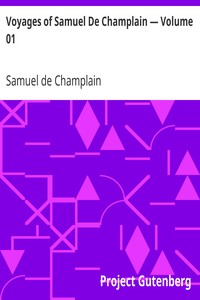
Read now or download (free!)
Similar books, about this ebook.
- Privacy policy
- About Project Gutenberg
- Terms of Use
- Contact Information

Search The Canadian Encyclopedia
Enter your search term
Why sign up?
Signing up enhances your TCE experience with the ability to save items to your personal reading list, and access the interactive map.
- MLA 8TH EDITION
- Lacombe, Michèle. "Des Sauvages, ou, Voyage de Samuel Champlain". The Canadian Encyclopedia , 16 December 2013, Historica Canada . www.thecanadianencyclopedia.ca/en/article/des-sauvages-ou-voyage-de-samuel-champlain. Accessed 29 September 2024.
- The Canadian Encyclopedia , 16 December 2013, Historica Canada . www.thecanadianencyclopedia.ca/en/article/des-sauvages-ou-voyage-de-samuel-champlain. Accessed 29 September 2024." href="#" class="js-copy-clipboard b b-md b-invert b-modal-copy">Copy
- APA 6TH EDITION
- Lacombe, M. (2013). Des Sauvages, ou, Voyage de Samuel Champlain. In The Canadian Encyclopedia . Retrieved from https://www.thecanadianencyclopedia.ca/en/article/des-sauvages-ou-voyage-de-samuel-champlain
- The Canadian Encyclopedia . Retrieved from https://www.thecanadianencyclopedia.ca/en/article/des-sauvages-ou-voyage-de-samuel-champlain" href="#" class="js-copy-clipboard b b-md b-invert b-modal-copy">Copy
- CHICAGO 17TH EDITION
- Lacombe, Michèle. "Des Sauvages, ou, Voyage de Samuel Champlain." The Canadian Encyclopedia . Historica Canada. Article published February 07, 2006; Last Edited December 16, 2013.
- The Canadian Encyclopedia . Historica Canada. Article published February 07, 2006; Last Edited December 16, 2013." href="#" class="js-copy-clipboard b b-md b-invert b-modal-copy">Copy
- TURABIAN 8TH EDITION
- The Canadian Encyclopedia , s.v. "Des Sauvages, ou, Voyage de Samuel Champlain," by Michèle Lacombe, Accessed September 29, 2024, https://www.thecanadianencyclopedia.ca/en/article/des-sauvages-ou-voyage-de-samuel-champlain
- The Canadian Encyclopedia , s.v. "Des Sauvages, ou, Voyage de Samuel Champlain," by Michèle Lacombe, Accessed September 29, 2024, https://www.thecanadianencyclopedia.ca/en/article/des-sauvages-ou-voyage-de-samuel-champlain" href="#" class="js-copy-clipboard b b-md b-invert b-modal-copy">Copy
Thank you for your submission
Our team will be reviewing your submission and get back to you with any further questions.
Thanks for contributing to The Canadian Encyclopedia.
Des Sauvages, ou, Voyage de Samuel Champlain
Article by Michèle Lacombe
Published Online February 7, 2006
Last Edited December 16, 2013
Des Sauvages, ou, Voyage de Samuel Champlain (1603) records Champlain 's first voyage to Canada as François Gravé du Pont's guest aboard La Bonne Renommée searching for the Northwest Passage . The 1603 summer voyage took them up the St Lawrence to the present location of Montréal ; Champlain describes the Gaspé coast, the Saguenay River and the Lachine Rapids. Cast as a diary, his first book of travels relates conversations with Mi'kmaq and Montagnais , and includes useful impressions of the climate and topography. Gravé du Pont took a Mi'kmaq family back to France, and Champlain contributed to the European fascination with the Indigenous people by recounting Indigenous legends and customs and telling of his attempt to convert Indigenous people to Christianity . Des Sauvages is included in the first Canadian edition of Champlain's complete works ( Oeuvres de Champlain , 6 vols, 1870) and in the standard Champlain Society edition (1922-35). A facsimile of Des Sauvages appeared in 1978.
Recommended

Pleure pas, Germaine
Théâtre de neptune en la nouvelle-france.
Samuel de Champlain
(1574 – 1635), "The Father of New France", was a French explorer, navigator, cartographer, soldier, geographer, ethnologist, diplomat, and chronicler. He founded Quebec City on July 3, 1608 and is important because he made the first accurate map of the coast.
- Amerigo Vespucci
- Ferdinand Magellan
- Article The First
- America’s Four Republics
- No Taxation Without PROPER Representation
Sunday, March 24, 2013

Among the curiosities of -newly-discovered America was the Indian canoe. Its slender and elegant form, its rapid movement, its capacity to bear burdens and resist the rage of the billows and torrents, excited no small degree of admiration for the skill by which it was constructed.

but for the mistake of Champlain, and the unwise treatment of the Five Nations that followed, the government of the continent would have fallen to the French rather than to the English.
The whole confederacy, except a little more than half of the Oneidas, hung like the scythe of death upon the rear of our settlements, and their deeds are inscribed with the scalping-knife and the tomahawk in characters of blood on the fields of Wyoming and Cherry Valley, and on the banks of the Mohawk.

"but for a headwind when off Cape Cod, sailing southward in 1605, Champlain might have reached the Hudson, and instead of planting Port Royal in Nova Scotia, he might have established its foundations on Manhattan Island, and that this would have made the greatest city in America a French city."

"He was wise, modest, and judicious in council; prompt, vigorous, and practical in administration; simple and frugal in his mode of life; persistent and unyielding in the execution of his plans; brave and valient in danger; unselfish, honest, and conscientious in the discharge of duty."

Have Fun With History
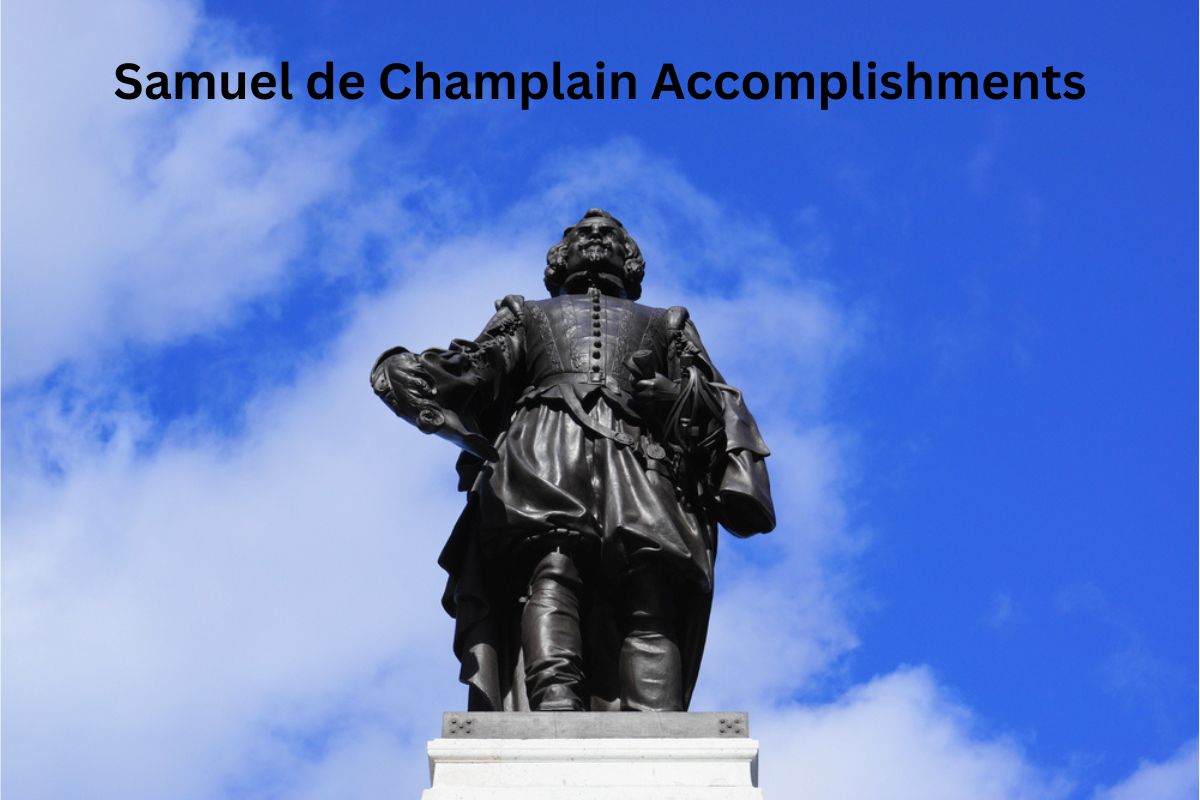
10 Samuel de Champlain Accomplishments and Achievements
Samuel de Champlain (1567-1635) was a French explorer, cartographer, and diplomat whose accomplishments played a pivotal role in shaping the early history of North America.
Known as the “Father of New France,” Champlain’s legacy encompasses a range of achievements, from the founding of key settlements to his intricate mapping, diplomacy with indigenous communities, and contributions to literature and religion.
His impact on the exploration and colonization of the continent left an indelible mark on the course of history.
Accomplishments of Samuel de Champlain
1. founded quebec in 1608.
Samuel de Champlain’s most significant achievement was the founding of Quebec, a key city that played a pivotal role in the colonization of New France.
In 1608, Champlain established a permanent settlement at the confluence of the St. Lawrence and St. Charles Rivers, naming it “Quebec.”
Also Read: Facts about Samuel de Champlain
This strategic location allowed for easier access to the interior of North America and facilitated trade and communication with both European and indigenous partners.
2. Explored and mapped the St. Lawrence River
Champlain conducted several voyages along the St. Lawrence River, exploring and meticulously mapping its various segments. His accurate maps improved navigation for future explorers, traders, and settlers.
By charting the river’s course, identifying its islands and natural features, and recording important geographical details, Champlain provided essential information for the effective colonization and development of the region.
3. Established trade relationships with Native American tribes
Champlain recognized the value of establishing positive relationships with the indigenous peoples of North America.
He cultivated alliances with tribes such as the Huron and Algonquin, fostering trade partnerships that were essential for the survival of the French colonies.
Champlain’s ability to build trust and collaboration with these Native American groups not only facilitated the fur trade but also contributed to a relatively peaceful coexistence during the early stages of colonization.
4. Created detailed maps of North American coastlines
Champlain’s cartographic talents were instrumental in advancing European understanding of North American geography.
He created highly detailed and accurate maps of the regions he explored, including the St. Lawrence River, the Atlantic coastline, and areas around the Great Lakes.
Champlain’s maps provided crucial information for subsequent explorers, traders, and settlers, guiding their journeys and helping them navigate previously uncharted territories with more confidence.
These maps also contributed to a more comprehensive understanding of the continent’s topography and layout.
5. Explored and mapped the Great Lakes
Champlain’s exploration extended beyond the St. Lawrence River. He ventured westward and became the first European to document the Great Lakes, including Lake Ontario and Lake Huron.
By mapping these vast bodies of water and the surrounding areas, Champlain significantly expanded European knowledge of North America’s interior. His exploration of the Great Lakes opened up new avenues for trade, as well as the potential for further westward expansion.
6. Contributed to settlements in Acadia
Champlain’s involvement in the colonization of Acadia, a region that includes parts of present-day Canada and the northeastern United States, showcased his commitment to establishing French presence in North America.
He played a role in the foundation of Port Royal (now Annapolis Royal, Nova Scotia) in 1605. This settlement marked one of the earliest European footholds in the area and laid the foundation for future French influence in Acadia.
Although Acadia would change hands between the French and the British multiple times, Champlain’s efforts played a role in shaping its early colonial history.
7. Acted as a diplomat between colonists and tribes
Champlain’s diplomatic skills were crucial in maintaining relationships with various Native American tribes. He recognized the importance of alliances and peaceful coexistence for the success of the French colonies.
Champlain’s ability to communicate and build trust with indigenous leaders helped prevent conflicts and ensured the continued operation of the fur trade. His diplomacy laid the foundation for positive interactions between French colonists and Native American communities.
8. Promoted Christianity among indigenous peoples
As a devout Catholic, Champlain saw his explorations as an opportunity to spread Christianity among the indigenous peoples he encountered.
He believed that converting the Native Americans to Christianity was not only a religious duty but also a means of cultural assimilation. Champlain’s efforts to introduce Christian teachings and practices had a lasting impact on the spiritual and cultural landscape of the region.
9. Wrote about his explorations in “Voyages”
Champlain’s written accounts of his travels and experiences, particularly in his work “Voyages,” were significant literary contributions of his time.
These writings provided invaluable insights into the geography, natural resources, indigenous cultures, and interactions with the Native American tribes.
His detailed descriptions and observations continue to be valuable historical records for researchers and scholars studying the early exploration and colonization of North America.
10. Established French influence in North America
Samuel de Champlain’s enduring legacy lies in his role as one of the key figures in establishing French influence in North America. His exploration, mapping, settlement efforts, and diplomatic skills helped shape the foundations of New France.
The city of Quebec, which he founded, remains an important cultural and historical center, and his efforts in diplomacy and trade relationships laid the groundwork for the unique relationship between French colonists and indigenous peoples.
Champlain’s legacy extends beyond his lifetime, as he played a pivotal role in shaping the course of early North American history.

Anna Van Densky blog
#VanDenskyBlog
Tillerson’s voyage to Moscow

Anna van Densky OPINION
It does not make much sense to discuss the possible outcome of Secretary of State Rex Tillerson’s (pictured) first visit to Moscow, because the new US administration was not given an opportunity to work out their political strategy, or even modify the concept of the Obama’s administration. From the moment of the inauguration the inner political struggle took all the energy and resource, hardly leaving an opportunity to bring to live any of campaign foreign policy promises, including the alliance with Russia against international terrorism.
While eager to play the doves of peace, the Democrats intentionally pushed the Republicans into the role of demons of war. The first visit of #Hillary to Moscow with a ‘reset button’ was a sheer public relations operation, however it worked on global popularity of Obama’s administration, profiling him on long-term as Nobel peace prize winner. On contrary the faux pas of the missile offensive in Syria shapes the image of Trump as a hawk, representing the unpredictable punitive forces with tyrannic inclinations, ignoring the international laws. Rex Tillerson’s mission is defined and shaped by this spontaneous US offensive in Syria.
However the US military action in Syria by no means is a result of a profound political thought, neither a beginning of a new strategy, but a haphazard tactical move to distract attention from #russianconnectons scandal during the initial period of Trump’s presidency.
It seems that in the eyes of President Trump’s advises the offensive in Syria is about a creation of a backdrop to spoil the game of the Democrats, an answer to #russianconnections allegations. The allegations intensely undermining president’s Trump image in an attempt of the Democrats to win majority in the Congress in the future.
Tillerson’s call to Russians to abandon president Assad is largely a rhetoric exercise for a number of reasons, not the least an absence of an alternative – there is no opposition figure in Syria able to take the responsibilities, and enhance the reconciliation process.
The talks about dismissing Assad in military action in ‘regime change’ favorite US concept are even more surrealistic after the assassination of Libya’s leader colonel Gaddafi, whose death marked a beginning of an ongoing turmoil, transferring the entire country in a huge playground of jihadists. Afghanistan, Iraq, Libya – the US foreign policy has demonstrated an out of ordinary capacity to destroy, but not reconstruct. Subsequently in Kremlin there is an understanding of that ‘creative capacity’ of the US, and certainly there is no slightest desire to give up a secular ally as Assad, who was educated in London, to one of the so-called ‘moderate opposition’ bearded fanatics.
The decision of Kremlin to decline the meeting between Putin and Tillerson indicates the initial pessimistic modality of the talks in Russian foreign ministry, because in first place there is no political agenda or strategy. Today State Department activity is a hostage of the warfare the Democrats declared to the Republican president, rejecting to accept his power and the choice of American people.
Without any new doctrine, scattered in tactical moves the US administration is chosing for spectacular actions and loud declarations to disguise its huge problems at home. No one expects any results from Tillerson-Lavrov (illustration) talks: Russians will not bow to the US to retreat from the Middle East, leaving Assad to the wolves and Americans, stuck with home politics problems, will continue to use tactic of distracting of public attention from its interior weakness and failures by the belligerent rhetoric and operations, flexing steroid muscles of the military-industrial complex, – the true master of the game behind the scenes.
Dulce bellum inexpertis! *
(* War seems lovely to unexperienced, Latin)
PUBLISHED in @EuropeDiplomatic
Sergey #Lavrov held talks with US Secretary of State Rex #Tillerson in #Moscow 🇷🇺 #RussiaUSA 🇺🇸 pic.twitter.com/hM4vn8Zlrr — MFA Russia 🇷🇺 (@mfa_russia) April 12, 2017
Share this:
Leave a comment cancel reply.

- Already have a WordPress.com account? Log in now.
- Subscribe Subscribed
- Copy shortlink
- Report this content
- View post in Reader
- Manage subscriptions
- Collapse this bar

IMAGES
VIDEO
COMMENTS
Samuel de Champlain, French explorer, acknowledged founder of the city of Quebec (1608), and consolidator of the French colonies in the New World. He was the first known European to sight Lake Champlain (1609) and made other explorations of what are now northern New York, the Ottawa River, and the eastern Great Lakes.
Samuel de Champlain (French: [samɥɛl də ʃɑ̃plɛ̃]; 13 August 1567 [2] [Note 1] [Note 2] - 25 December 1635) was a French explorer, navigator, cartographer, draftsman, soldier, geographer, ethnologist, diplomat, and chronicler. He made between 21 and 29 trips across the Atlantic Ocean, [3] and founded Quebec City, and New France, on 3 July 1608.An important figure in Canadian history ...
First Explorations and Voyages. Champlain's earliest travels were with his uncle, and he ventured as far as Spain and the West Indies. From 1601 to 1603, he was a geographer for King Henry IV, and ...
Learn about the life and voyages of Samuel de Champlain, a French explorer and cartographer who founded Quebec and mapped the St. Lawrence River and the Great Lakes. Explore his biography, maps, drawings, and legacy in the New World.
In: Samuel de Champlain, Les voyages, Paris, 1613. In the summers of 1605 and 1606 Champlain made reconnaissance voyages along the North American coast to assess the potential for trade and settlement farther south, reaching his farthest-south point at Nauset on Cape Cod in the summer of 1606. The chart shown here of "Beau Port," modern-day ...
Learn about the life and achievements of Samuel de Champlain, the "Father of New France", who explored and mapped the St. Lawrence River and the Atlantic coast. Discover the mystery of his birth date and place, and his role as a hydrographer royal and a fur trader.
Samuel de Champlain took several voyages to Canada, where he mapped the St. Lawrence River and became the first European to discover the Great Lakes. Click on the world map to view an example of the explorer's voyage. How to Use the Map. After opening the map, click the icon to expand voyage information;
xiii, 377 p. : 23 cm Series title also at head of t.p "This volume presents the texts of the Voyages of 1613 and the Voyages et descouvertures of 1619, as given in the excellent translation by Dr. Charles Pomeroy Otis, in the second and third volumes of the late Dr. Edmund F. Slafter's Voyages of Samuel de Champlain, published in three volumes by the Prince society."--Note
The voyages and explorations of Samuel de Champlain, 1604-1616 ... p. 1-147) is a translation of Les voyages de la Novvelle France occidentale, dicte Canada, Paris, 1632 On cover: The trail makers Includes bibliographical references 39 52 Notes. some unnumbered illustrations. Addeddate 2011-03-22 02:39:12
Samuel de Champlain, cartographer, explorer, colonial administrator, author (born circa 1567 in Brouage, France; died 25 December 1635 in Quebec City). Known as the "Father of New France," Samuel de Champlain played a major role in establishing New France from 1603 to 1635. He is also credited with founding Quebec City in 1608. He explored the Atlantic coastline (in Acadia), the Canadian ...
Samuel de Champlain was born in La Rochelle, France to a family of mariners. He gained experience as a navigator through voyages with his uncle, notable fur trader François Gravé Du Pont, who traveled and traded in the New World as early as 1599. The knowledge of the New World gained on these journeys proved valuable for Pierre Dugua, Sieur ...
xiii, 377 pages 23 cm Series title also at head of t.p "This volume presents the texts of the Voyages of 1613 and the Voyages et descouvertures of 1619, as given in the excellent translation by Dr. Charles Pomeroy Otis, in the second and third volumes of the late Dr. Edmund F. Slafter's Voyages of Samuel de Champlain, published in three volumes by the Prince Society."--Note
Samuel De Champlain. Before this was New England, it was known by the French as New France. In 1605, a French expedition under the leadership of Sieur de Monts, with Champlain as cartographer, sailed from St. Croix, in Acadia, to find a more suitable location for the struggling French colony. The voyage of exploration took them south along the ...
Summary. "Voyages of Samuel De Champlain — Volume 01" by Samuel de Champlain is a historical account written in the late 19th century that details the life and explorations of Samuel de Champlain, a key figure in the early French colonization of the Americas. The text offers a comprehensive look at his voyages, interactions with Indigenous ...
Des Sauvages, ou, Voyage de Samuel Champlain. Des Sauvages, ou, Voyage de Samuel Champlain (1603) records Champlain's first voyage to Canada as François Gravé du Pont's guest aboard La Bonne Renommée searching for the Northwest Passage.The 1603 summer voyage took them up the St Lawrence to the present location of Montréal; Champlain describes the Gaspé coast, the Saguenay River and the ...
Samuel de Champlain (1567-1635) first became known when his reports of his travels to the West Indies and Central America with a Spanish expedition in 1598 caught the attention of the French King, Henri IV. In 1603, Champlain made his first trip to North America, to the St. Lawrence River to explore and establish a French colony.
Samuel de Champlain. Samuel de Champlain (August 13, 1574 - December 25, 1635), "The Father of New France", was a French explorer, navigator, cartographer, soldier, geographer, ethnologist, diplomat, and chronicler. He founded Quebec City on July 3, 1608 and is important because he made the first accurate map of the coast.
1. Founded Quebec in 1608. Samuel de Champlain's most significant achievement was the founding of Quebec, a key city that played a pivotal role in the colonization of New France. In 1608, Champlain established a permanent settlement at the confluence of the St. Lawrence and St. Charles Rivers, naming it "Quebec.".
Voyages of Samuel de Champlain, 1604-1608: Author: Champlain, Samuel de, 1567-1635: Contributor: Otis, Charles Pomeroy (translator) Document Source: Champlain, Samuel de. Voyages of Samuel de Champlain. Translated from the French by Charles Pomeroy Otis. With Historical Illustrations, and a Memoir by the Rev. Edmund F. Slafter. (Boston: Prince ...
Anna van Densky OPINION It does not make much sense to discuss the possible outcome of Secretary of State Rex Tillerson's (pictured) first visit to Moscow, because the new US administration was not given an opportunity to work out their political strategy, or even modify the concept of the Obama's administration. From the moment of the…
Champlain, Samuel de, 1567-1635. Title: Voyage of Samuel de Champlain, 1604-1608: Source: Champlain, Samuel de. Voyages of Samuel de Champlain. Translated from the French by Charles Pomeroy Otis. With Historical Illustrations, and a Memoir by the Rev. Edmund F. Slafter. (Boston: Prince Society, 1878).
Please Subscribe =) Road to 100K!- Full Playlist: https://www.youtube.com/playlist?list=PLz1UQhw0O7bZmHen1FJudpHK_MryCq6-JWalkthrough00:00 Intro- CHAPTER 20:...
The correct answer is under A.. Henry Hudson (1570-1611) was a famous English navigator and explorer in the late 16th and early 17th centuries. When he embarked on explorations of North America and the Arctic, England was ruled by Queen Elizabeth I, from 1558 until she died in 1603.The student should be reminded that Queen Elizabeth I, is known for perhaps even sponsoring research the most.